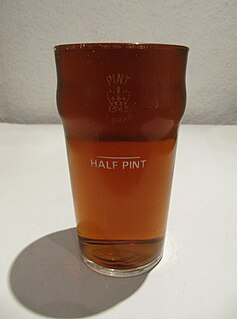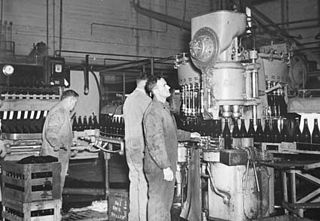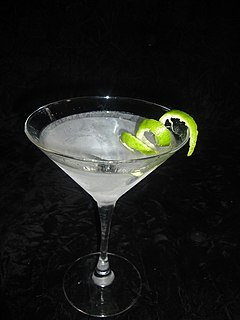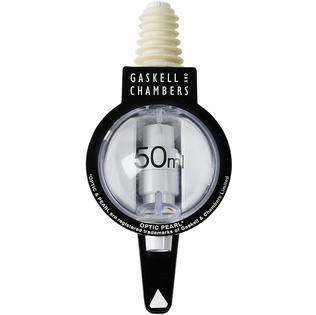Related Research Articles

In recipes, quantities of ingredients may be specified by mass, by volume, or by count.

The pint is a unit of volume or capacity in both the imperial and United States customary measurement systems. In both of those systems it is traditionally one eighth of a gallon. The British imperial pint is about 20% larger than the American pint because the two systems are defined differently. Almost all other countries have standardized on the metric system, so the size of what may be called a pint varies depending on local custom.

A wine bottle is a bottle, generally made of glass, that is used for holding wine. Some wines are fermented in the bottle, others are bottled only after fermentation. Recently the bottle has become a standard unit of volume to describe sales in the wine industry, measuring 750 millilitres. Wine bottles are produced, however, in a variety of volumes and shapes.

A shot glass is a small glass originally designed to hold or measure spirits or liquor, which is either imbibed straight from the glass or poured into a cocktail. An alcoholic beverage served in a shot glass and typically consumed quickly, in one gulp, may also be known as a "shooter".
Rolling Rock is a 4.4% abv American lager launched in 1939 by the Latrobe Brewing Company. Although founded as a local beer in Western Pennsylvania, it was marketed aggressively and eventually became a national product. The brand was sold to Anheuser-Busch of St. Louis, Missouri, in mid-2006, which transferred brewing operations to New Jersey while continuing to label the new beer prominently with the name of Latrobe.

A cocktail shaker is a device used to mix beverages by shaking. When ice is put in the shaker this allows for a quicker cooling of the drink before serving.

A beer bottle is a bottle designed as a container for beer. Such designs vary greatly in size and shape, but the glass commonly is brown or green to reduce spoilage from light, especially ultraviolet.

A keg is a small barrel.

Beer arrived in Australia at the beginning of British colonisation. In 2004 Australia was ranked fourth internationally in per capita beer consumption, at around 110 litres per year; although, the nation ranked considerably lower in a World Health Organization report of alcohol consumption per capita of 12.2 litres. Lager is by far the most popular type of beer consumed in Australia.

A pint glass is a form of drinkware made to hold either a British ("imperial") pint of 20 imperial fluid ounces (568 ml) or an American pint of 16 US fluid ounces (473 ml). Other definitions also exist, see below. These glasses are typically used to serve beer, and also often for cider.

The gimlet is a cocktail typically made of 2 parts gin and 1 part lime juice. A 1928 description of the drink was: gin, and a spot of lime. The description in the 1953 Raymond Chandler novel The Long Goodbye stated that "a real gimlet is half gin and half Rose's lime juice and nothing else." This is in line with the proportions suggested by The Savoy Cocktail Book (1930), which specifies one half Plymouth Gin and one half Rose's Lime Juice Cordial. However, modern tastes are less sweet, and generally provide for at least two parts gin to one part of the lime and other non-alcoholic elements.

Various unique terminology is used in bartending.
A pony is a small horse.

Beer glassware comprises the drinking vessels made of glass designed or commonly used for drinking beer. Different styles of glassware exist for a number of reasons: they may reflect national traditions; legislation regarding serving measures; practicalities of stacking, washing and avoiding breakage; promotion of commercial breweries; folk art, novelty items or use in drinking games; or complementing different styles of beer for a variety of reasons, including enhancing aromatic volatiles, showcasing the appearance, and having an effect on the beer head. Several kinds of beer glassware have a stem which serves to prevent the body heat of the drinker's hand from warming the beer. Some countries require fill lines on glasses to ensure customers receive the full volume of beer ordered.

A schooner is a type of glass for serving drinks. In the United Kingdom it is the name for a large sherry glass. In Australia it is the name for a particular glass size, used for any type of beer.

Alcoholic spirits measures are instruments designed to measure exact amounts or shots of alcoholic spirits.
A number of units of measurement were used in South Africa to measure quantities like length, mass, capacity, etc. The Imperial system of measurements was finally made standard in 1922 and the metric system was adopted in 1970.

A growler is a glass, ceramic, plastic, or stainless steel bottle used to transport draft beer in the United States, Canada, Australia, Brazil and other countries. They are commonly sold at breweries and brewpubs as a means to sell take-out craft beer. Rarely, beers are bottled in growlers for retail sale. The significant growth of craft breweries and the growing popularity of home brewing has also led to an emerging market for the sale of collectible growlers. Some U.S. grocery stores, convenience stores, bars and restaurants have growler filling stations.

A fill line is a marking on drinkware indicating the volume of liquid held by the glass. Many countries mandate fill lines on glasses used commercially as a consumer protection measure.
References
- ↑ CocktailDB
- ↑ Mr. Boston Bartender's Guide, Mr. Boston Distiller Corporation, Boston, 1978, back endpapers
- ↑ Notes and Queries, August 8th, 1896, p. 126: “It seems probable the origin is due to the diminutiveness of the glass;”
“The expression ‘a pony of beer’ is often used in South Wales for a small glass containing about the fourth of a pint.” - ↑ Curtis, Wayne (2018-09-26). "Mixopedia: Pony Glass". Imbibe Magazine. Retrieved 2019-04-24.
| This article about an item of drinkware or tool used in preparation or serving of drink is a stub. You can help Wikipedia by expanding it. |
| This beer or brewery-related article is a stub. You can help Wikipedia by expanding it. |